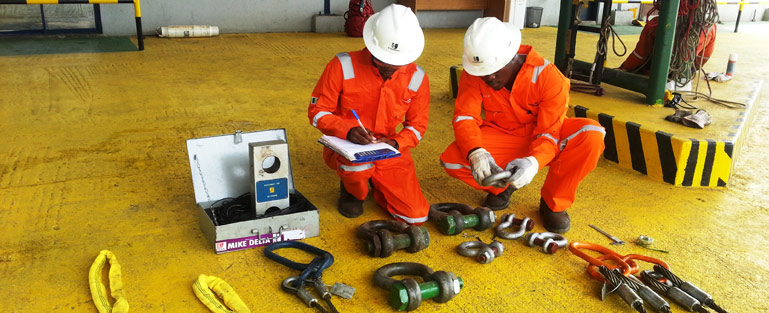HOW TO INSpECT LIFTING SHACKLES

11 WAYS TO INSPECT LIFTING SHACKLES
Shackles are important lifting accessories that are basically used to connect load to lifting appliances. Hence, a thorough inspection is often required to ascertain the integrity of shackles.
Below is a step by step process to conducting a thorough examination of shackles.
- Assess documentation such as declaration of conformity (DoC)/ Manufacturer certificate (MC) and any previous report as well as safe use instructions.
- Examine markings, such as CE mark, manufacturer name, symbol or code, grade number, WLL/SWL,traceability code, pins with a diameter ≥ 13mm often marked with the grade number, manufacturer name, symbol or code and traceability code.
- Thoroughly examine component parts, especially the body and pin. Ensure that there are no distortions and verify dimensions. Make sure the component parts are free of damage, excessive wear, corrosion and nicks/gouges or forging defects e.g. unfilled section, small cracks/folds at corners, scale pits, lapping etc.
- Secure nut and split pin. Examine pin tolerances. Ensure the body and the pin are both same brand and type. Check component functionality. Functionality examination is required if the shackle is fitted with, for example, a locking clamp, spring release mechanism, etc.
- Assess operational ambient temperature: -20°C/-4°F to +200°C/+392°F
- Assess exposure to chemicals. Ensure that the shackle is not immersed in acidic solutions or exposed to acid fumes without the approval of the manufacturer. Exposure to chemicals could affect the integrity of shackles.
- Conduct NDT where required. Magnetic Particle Inspection (MPI) or Dye Penetrant Inspection (DPI) can be used if the competent person considers it essential to further assess component integrity and produce the NDT report if completed.
- Testing: Proof load testing is carried out if the competent person considers it essential to further assess equipment/component integrity. Ensure that proof loads comply with manufacturer’s instructions or applicable British Standard or any other relevant verification criteria. The equipment should be thoroughly examined before and after testing.
- Colour code, if applicable and ensure that it does not cover important information on the shackle. Although, marking is not normally required after thorough examination or testing.
- Produce a detailed report
- Plan a full-scale thorough examination of lifting gears with JC International. Contact us : Lagos: 0805 519 2672, Port Harcourt: 0805 599 9315

Leave a Reply